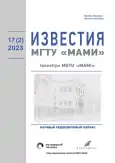Влияние последовательностей переключений на баланс напряжения нейтральной точки в трёхуровневом инверторе напряжения
- Авторы: Шишков А.Н.1, Дудкин М.М.2, Ле В.1
-
Учреждения:
- Московский политехнический университет
- Южно-Уральский государственный университет (Национальный исследовательский университет)
- Выпуск: Том 17, № 2 (2023)
- Страницы: 195-206
- Раздел: Электротехнические комплексы и системы
- URL: https://journal-vniispk.ru/2074-0530/article/view/253976
- DOI: https://doi.org/10.17816/2074-0530-125204
- ID: 253976
Цитировать
Полный текст
Аннотация
Обоснование. Обеспечение баланса напряжения нейтральной точки звена постоянного тока в допустимых пределах является одним из обязательных требований в процессе эксплуатации трёхуровневых автономных инверторов напряжений с фиксированной нейтральной точкой. Как известно, дисбаланс напряжения нейтральной точки может неблагоприятно повлиять на работу инвертора и нагрузки в целом, привести к выводу из строя как силовых ключей, так и конденсаторов в звене постоянного тока. Дисбаланс напряжения нейтральной точки чаще всего происходит из-за несимметрии номинальных величин конденсаторов постоянного тока, несогласованных свойств коммутационных силовых приборов, несимметричной трёхфазной нагрузки, а также из-за несовершенства алгоритма управления преобразователем.
Цель работы выбор оптимальной последовательности, обеспечивающей наименьшее отклонение напряжения нейтральной точки и число переключений силовых ключей в трёхуровневом инверторе напряжения.
Материалы и методы. Для объективного сравнения рассмотренных последовательностей переключений и их влияния на баланс напряжения нейтральной точки в программе MATLAB/Simulink была разработана компьютерная модель трёхуровневого инвертора напряжения. Для управления данным инвертором использован метод пространственно-векторной широтно-импульсной модуляции с тремя разными последовательностями переключений: пятиступенчатой, семиступенчатой и стандартной.
Результаты. Приведена топология трёхуровневого инвертора напряжения с фиксированной нейтральной точкой. Сняты экспериментальные зависимости ошибки отклонения напряжения нейтральной точки при изменении коэффициента модуляции, частоты основной гармоники на выходе инвертора и свойств нагрузки для трёх различных последовательностей включения силовых ключей.
Заключение. В данной работе исследованы влияние базовых векторов и влияние последовательностей переключения силовых ключей на баланс напряжения нейтральной точки. Комбинации состояний больших и нулевых базовых векторов не влияют на напряжение нейтральной точки. Для средних базовых векторов напряжение нейтральной точки может повышаться или понижаться в зависимости от условий работы инвертора. Малые базовые векторы значительно влияют на напряжение нейтральной точки. С учётом всего вышесказанного наилучшей последовательностью переключений для трёхуровневого инвертора следует считать семиступенчатую последовательность, обеспечивающую как оптимальный баланс напряжения нейтральной точки, так и уровень коммутационных потерь в силовых ключах.
Полный текст
Открыть статью на сайте журналаОб авторах
Александр Николаевич Шишков
Московский политехнический университет
Email: shan1982@mail.ru
ORCID iD: 0000-0001-9851-8745
SPIN-код: 5099-9286
Scopus Author ID: 43861781400
ResearcherId: A-4517-2014
доцент, канд. техн. наук, заведующий кафедрой Электрооборудование и промышленная электроника
Россия, 107023, Москва, ул. Большая Семеновская, д. 38Максим Михайлович Дудкин
Южно-Уральский государственный университет (Национальный исследовательский университет)
Email: dudkinmax@mail.ru
ORCID iD: 0000-0003-4876-8775
SPIN-код: 5703-3117
Scopus Author ID: 55755728100
доктор техн. наук, профессор кафедры Электропривод мехатроника и электромеханика
Россия, 454080, Уральский федеральный округ, Челябинск, просп. В.И. Ленина, д. 76Ван Кань Ле
Московский политехнический университет
Автор, ответственный за переписку.
Email: canhlv.mta@gmail.ru
ORCID iD: 0009-0007-5183-6077
аспирант кафедры «Электрооборудование и промышленная электроника»
Россия, 107023, Москва, ул. Большая Семеновская, д. 38Список литературы
- Gorozhankin A.N., Dudkin M.M. Algorithms and Control Systems for Electric Drives of Cold Pipe-Rolling Mills // Russian Electrical Engineering. 2020. Vol. 91, № 7. P. 440–446. doi: 10.3103/s1068371220070068
- Дудкин М.М. Энергосберегающие технологии в испытательных стендах с использованием однофазных обратимых преобразователей // Вестник ЮУрГУ. Серия «Энергетика». 2013. Т. 13, № 1. С. 5–18.
- Храмшим Р.Р., Храмшин Т.Р., Храмшина Е.А., и др. Многоуровневый высоковольтный преобразователь частоты для электропривода // Известия Тульского государственного университета. Технические науки. 2010. C. 191-196.
- Донской Н., Иванов А., Матисон В., и др. Многоуровневые автономные инверторы для электропривода и электроэнергетики // Силовая Электроника. 2008. № 1. C. 43-46.
- Макаров В.Г., Хайбрахманов Р.Н. Многоуровневые инверторы напряжения. Обзор топологий и применение // Вестник технологического университета. 2016. Т.19. № 22. C. 134-138.
- Лазарев С.А. Применение инверторов напряжения в высоковольтном электроприводе // Экспозиция Нефть Газ. 2013. С. 31-35.
- Peddapelli S.K. Pulse Width Modulation: Analysis and Performance in multilevel inverter. Oldenbourg: De Gruyter Oldenbourg, 2017.
- Holmes G.D., Lipo T.A. Pulse Width Modulation for Power Converters: Principles and Practice. New York: Wiley-IEEE Press, 2003.
- Choi U.-M., Lee K.-B. Neutral-Point Voltage Balancing Method for Three-Level Inverter Systems with a Time-Offset Estimation Scheme // Journal of Power Electronics. 2013. Vol. 13. № 2. P. 243–249. doi: 10.6113/JPE.2013.13.2.243
- Абулвелеев И.Р., Храмшин Т.Р., Корнилов Г.П., и др. Принципы построения векторной широтно-импульсной модуляции для трехуровневого инвертора // Электротехнические системы и комплексы. 2016. № 4 (33). C. 72-77.
- Busquets-Monge S., Bordonau J., Boroyevich D., et al. The nearest three virtual space vector PWM - a modulation for the comprehensive neutral-point balancing in the three-level NPC inverter // IEEE Power Electronics Letters. 2004. Vol. 2, N 1. doi: 10.1109/LPEL.2004.828445
- Гельман М.В., Дудкин М.М. Вентильные преобразователи постоянного и переменного тока. Челябинск: Изд. центр Южно-Уральского государственного университета, 2013.
- Lewicki A., Krzeminski Z., Abu-Rub H. Space-Vector Pulse width Modulation for Three-Level NPC Converter With the Neutral Point Voltage Control // IEEE Transactions on Industrial Electronics. 2011. Vol. 58, N 11. P. 5076-5086. doi: 10.1109/TIE.2011.2119453
- Koyama M., Fujii T., Uchida R., et al. Space voltage vector-based new PWM method for large capacity three-level GTO inverter // Proceedings of the 1992 International Conference on Industrial Electronics, Control, Instrumentation, and Automation. San Diego: IEEE, 1992. P. 271-276. doi: 10.1109/IECON.1992.254621.
Дополнительные файлы




















